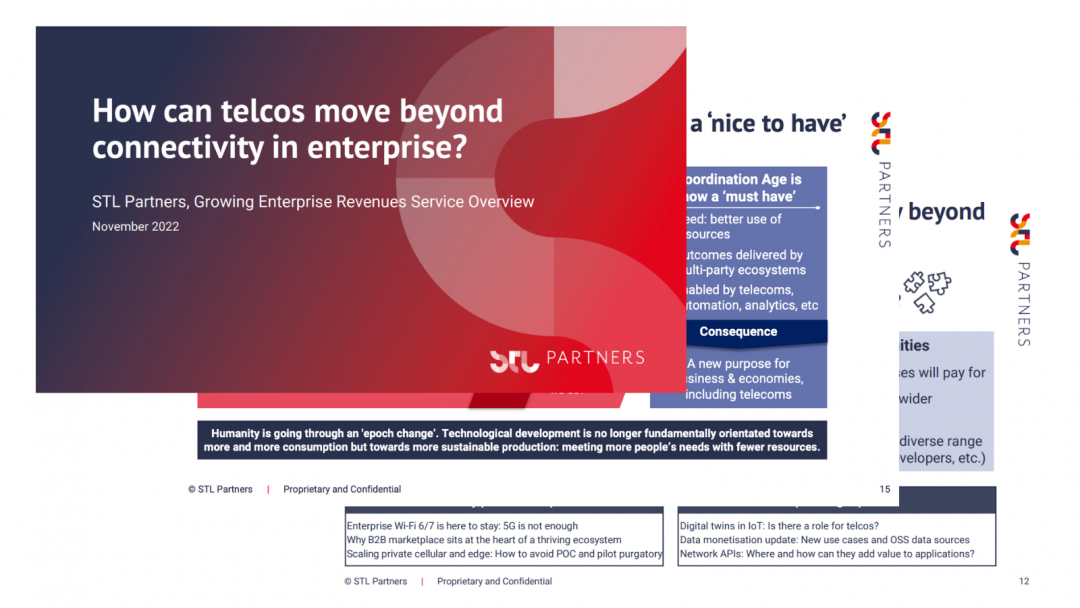
B2B2X marketplaces: what, why, and how?
Earlier this year, STL Partners worked with TELUS Health to determine the opportunity that a B2B2X marketplace approach offers telcos. Through this research, we created a telco framework for a marketplace approach, leveraging a telcos central position in the coordination of data and parties to construct a dynamic, verticalized ecosystem of ISVs, SIs, and enterprise customers around them.
Why should telcos care about B2B2X marketplaces?
To answer why telcos should care about B2B2X marketplaces, we ran an extensive research programme with operators and hyperscalers who are actively exploring the B2B opportunity. Most operators who we interviewed were clear on the need to capitalise on the potential revenue that a strong enterprise proposition represents, and the necessity of a vibrant and dynamic ecosystem to capture this opportunity. At STL Partners, we have previously researched the ecosystem approach and how it relates to the telco. In this project, we analysed how a B2B2X marketplace strategy – taking lessons from successful examples in mobile applications and cloud solutions – could instigate the creation of this vertical ecosystem of application providers, integrators, customers, with the telco positioned at its centre.
What is a marketplace?
We define a marketplace as a centralised platform for a distributed ecosystem of suppliers and customers, allowing buyers and sellers to effectively and efficiently transact.
Using Amazon as an example, we describe the four key actors within a marketplace as follows:

1. Customers: users of the Amazon marketplace are given a simple purchasing journey, with intuitive comparative tools to empower their decision. As they are making their purchase, all friction has been removed to increase the likelihood of a completed transaction. In an enterprise context, identification and comparison tools are the primary value-add, with a “one click purchasing” journey is less likely to apply in a complex enterprise environment with SLAs to consider. Instead, enterprise customers want to understand the variation in the offering of certain suppliers and the ROI they can ultimately provide.
2. Suppliers: suppliers on the Amazon marketplace are free to list their product once they are a verified seller. They are not necessarily affiliated with Amazon itself, instead using the platform to reach a larger customer base than would otherwise be possible. Suppliers in an enterprise context offer vertical solution elements, from end devices, connectivity, applications, etc. A marketplace offers suppliers a far-reaching distribution channel for their product, whilst also creating an integrated ecosystem of partners with whom they can co-develop to create pre-packaged solutions for potential customers. Access to this ecosystem is a key motivation for suppliers as they onboard into a marketplace environment.
3. Orchestrators: Amazon defines the specifications of their marketplace. They create the requirements for suppliers, as well as dictating the customer journey. They are also charged with managing the marketplace, bringing new customers to the platform, and ensuring its general performance. For enterprise, the orchestrator is charged with defining the characteristics of the marketplace; outlining collaboration guidelines, onboarding requirements, as well as marketing the marketplace to new participants to extend its reach. They provide insights, manage supplier and customer experience, and are responsible for scaling the marketplace. Critically, the orchestrator defines how data is captured and shared between suppliers, ultimately impacting the levels of dynamic collaboration possible within the marketplace.
4. Enablers: enablers provide the back-end of the marketplace. Billing, authentication, onboarding, fulfilment, delivery, settlement are managed by the enablement platform that automates these functions. The enablement roles can be fulfilled by the orchestrator in some instances (Amazon being the foremost example) where the orchestrator is a larger organisation with the capabilities and resource to build these capabilities as well as the desire to have more end-to-end oversight of the marketplace.
Why should telcos be exploring B2B2X as a strategic investment?
Building a vertical strategy is rapidly becoming a priority for many telcos around the globe, especially with the emergence of 5G. 5G has been developed to enable B2B customers to create dynamic tools and upgrade their organisation and products through closer interfacing with the network, implementing AI models and automated processes to their operations.
Fulfilling the promise of 5G relies on ecosystems of partners who can access network services and help telcos in building E2E solutions on top of the network as a platform. To fully capitalise on the B2B opportunity, telcos must build a strong partner programme with the ecosystem, expanding on their connectivity expertise and brand status with enterprises to develop a more verticalized proposition.
Marketplaces create the nucleus around which this ecosystem can form and operate. They provide a tangible “structure” and “purpose” for telcos to engage partners and bring new solutions to customers.
Coordinating engagement and information sharing between disparate parties lies at the heart of a telco’s competencies, connecting a diverse range of organisations and datasets, and provides them with a unique proposition as it relates to a marketplace strategy. Telcos are already a trusted connectivity partner, providing them with a strong brand position as potential orchestrator of a marketplace, collating a fragmented group of stakeholders around themselves.
Although the most radical and transformative strategy would position the telco as the orchestrator and enabler of a marketplace, they can also benefit from participating in existing vertical marketplaces as a supplier of connectivity, managed services and integration services to enterprise as they look to stimulate B2B growth. Despite the focus of traditional telco stakeholders to prioritise the expansion of core connectivity customers and a pursuit of proven ROI, the support and integration services that telcos can offer to enterprise customers offers potential value, allowing the enterprise to interact with a single party (in this instance, the telco). Offering these services on an existing vertical marketplace will establish the telco brand as a reputable partner with experience of working in the industry, thereby encouraging future business.
What should a B2B marketplace look like?
An ideal marketplace involves free access to data (both that of the suppliers and the customers), one-touch purchasing journeys, powerful comparative tools, and innovative listed products. Below, we identify 6 characteristics operators should consider/understand as part of a B2B marketplace. For many verticals however, one or more of these “ideals” must be sacrificed to reflect the requirements of the industry.

STL Partners’ six characteristics of a marketplace provides a framework for defining the nature of a marketplace. Depending on the industry, an orchestrator may choose to move the lever on any one of these characteristics to the left or right, reflecting the demands of the customer and the organisations which supply it with solutions. Our work with TELUS showed how this would work in a healthcare context.
Healthcare requires stringent certification and auditing of solutions and vendors on the marketplace to avoid possibly catastrophic repercussions to mission critical processes. Though this sacrifices potential innovation and fluid data sharing between suppliers, in order to maintain the trust of customers in a healthcare context, certification of applications is imperative. Similarly, a financial services marketplace would require significantly decreased sharing of customer knowledge to stay within regulatory guidelines.
You can read about this in more depth in our full research report, which can be found here: https://stlpartners.com/research/why-b2b-marketplace-sits-at-the-heart-of-a-thriving-ecosystem/
Next Steps
With the right execution, a marketplace strategy could be a formative foundation for telcos looking to verticalize their organisation. In combination with a tactical approach to building an ecosystem, choosing the right partners at the right time, and by building a strong understanding of the vertical industry, telcos are well positioned to build a B2B solution catalogue with themselves at its centre. If you would like to find out more about how this applies to your organisation, please reach out to us at tim.otto@stlpartners.com.
Download this article as a PDF
Read more about growing enterprise revenues
Growing Enterprise Revenues overview pack
Our overview pack explores how the telecoms industry can leverage new business models to meet enterprise customer needs
Telco APIs and Open Gateway: You can’t make an omelette without breaking some eggs
This article provides an assessment of where the market is to date post-MWC Barcelona, and what telcos can do to accelerate the opportunity.
Telco managed cybersecurity: incorporating cloud native application security
While the move to cloud native is a top priority for many enterprises, it introduces new security risks. There are individual solutions that minimise this risk, but a unified platform can offer a holistic approach. Telcos could strengthen their offerings by incorporating such platforms into their managed security services.
The Economy of Things: enabling the monetisation of IoT data
The Economy of Things (EoT) represents the natural transition of the Internet of Things (IoT). Whilst the IoT enables the generation of data from their devices and their sensors, the EoT can provide the means for the data to be transacted and monetised across a multi-participatory ecosystem. By 2030, at STL Partners we forecast that there will be 3.3 billion EoT enabled devices worldwide.





